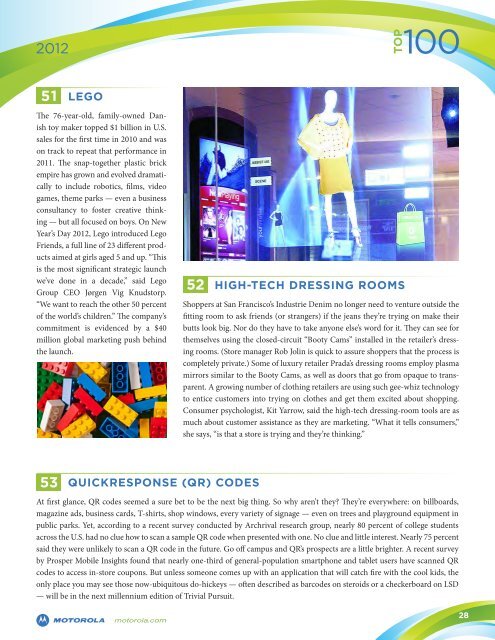2012 100 - Networld Media Group
2012 100 - Networld Media Group
2012 100 - Networld Media Group
Create successful ePaper yourself
Turn your PDF publications into a flip-book with our unique Google optimized e-Paper software.
51<br />
LEGO<br />
The 76-year-old, family-owned Danish<br />
toy maker topped $1 billion in U.S.<br />
sales for the first time in 2010 and was<br />
on track to repeat that performance in<br />
2011. The snap-together plastic brick<br />
empire has grown and evolved dramatically<br />
to include robotics, films, video<br />
games, theme parks — even a business<br />
consultancy to foster creative thinking<br />
— but all focused on boys. On New<br />
Year’s Day <strong>2012</strong>, Lego introduced Lego<br />
Friends, a full line of 23 different products<br />
aimed at girls aged 5 and up. “This<br />
is the most significant strategic launch<br />
we’ve done in a decade,” said Lego<br />
<strong>Group</strong> CEO Jørgen Vig Knudstorp.<br />
“We want to reach the other 50 percent<br />
of the world’s children.” The company’s<br />
commitment is evidenced by a $40<br />
million global marketing push behind<br />
the launch.<br />
53<br />
52<br />
QUICKRESPONSE (QR) CODES<br />
HIGH-TECH DRESSING ROOMS<br />
Shoppers at San Francisco’s Industrie Denim no longer need to venture outside the<br />
fitting room to ask friends (or strangers) if the jeans they’re trying on make their<br />
butts look big. Nor do they have to take anyone else’s word for it. They can see for<br />
themselves using the closed-circuit “Booty Cams” installed in the retailer’s dressing<br />
rooms. (Store manager Rob Jolin is quick to assure shoppers that the process is<br />
completely private.) Some of luxury retailer Prada’s dressing rooms employ plasma<br />
mirrors similar to the Booty Cams, as well as doors that go from opaque to transparent.<br />
A growing number of clothing retailers are using such gee-whiz technology<br />
to entice customers into trying on clothes and get them excited about shopping.<br />
Consumer psychologist, Kit Yarrow, said the high-tech dressing-room tools are as<br />
much about customer assistance as they are marketing. “What it tells consumers,”<br />
she says, “is that a store is trying and they’re thinking.”<br />
At first glance, QR codes seemed a sure bet to be the next big thing. So why aren’t they? They’re everywhere: on billboards,<br />
magazine ads, business cards, T-shirts, shop windows, every variety of signage — even on trees and playground equipment in<br />
public parks. Yet, according to a recent survey conducted by Archrival research group, nearly 80 percent of college students<br />
across the U.S. had no clue how to scan a sample QR code when presented with one. No clue and little interest. Nearly 75 percent<br />
said they were unlikely to scan a QR code in the future. Go off campus and QR’s prospects are a little brighter. A recent survey<br />
by Prosper Mobile Insights found that nearly one-third of general-population smartphone and tablet users have scanned QR<br />
codes to access in-store coupons. But unless someone comes up with an application that will catch fire with the cool kids, the<br />
only place you may see those now-ubiquitous do-hickeys — often described as barcodes on steroids or a checkerboard on LSD<br />
— will be in the next millennium edition of Trivial Pursuit.<br />
28



